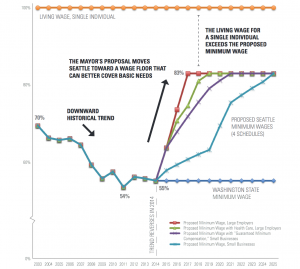 A new report, “Reversing the Trend” by the Alliance for a Just Society, finds that Mayor Ed Murray’s minimum wage proposal reverses a minimum wage trend that is increasingly unable to meet the basic living needs of workers. Seattle’s proposed $15 minimum wage would be the highest in the country.
A new report, “Reversing the Trend” by the Alliance for a Just Society, finds that Mayor Ed Murray’s minimum wage proposal reverses a minimum wage trend that is increasingly unable to meet the basic living needs of workers. Seattle’s proposed $15 minimum wage would be the highest in the country.
Analyzing more than a decade of data, this chart shows that while the path to a $15 an hour minimum wage is a step in the right direction toward addressing income inequality – living wage still exceeds projected minimum wage levels offered in the mayor’s model.
In addition, the study shows that a $15 minimum wage would not have been enough to support a single parent and child even back in 2003, and it would not have been enough to make ends meet for a single person as far back as 2010.
The Alliance for a Just Society and Washington Community Action Network released the study together today, comparing 10 years of statewide living wage levels with historical earnings and the mayor’s minimum wage model.
However, the study finds that in as soon as three years — depending on household and wage category — the gap between minimum wage and a living wage narrows to its smallest point in a decade. The mayor’s proposal gets minimum wage workers closer to living wages than at any other time in our analysis, within 83 percent.
“This report makes it clear that Seattle’s $15 minimum wage is a very modest proposal for closing the gap, it isn’t anywhere near the entire solution,” said LeeAnn Hall, executive director of the Alliance for a Just Society.
“We are calling on the City Council to enact a more livable wage for Seattle’s families,” said Will Pittz, executive director of Washington CAN! “It’s unacceptable that a full-time employee in Seattle or anywhere in Washington, can’t cover even their most basic living expenses.”
The study assumes a 40-hour workweek, employer-paid health care, and no public assistance.
Chart: Reversing.the.Trend_Graphic CHART
Policy report: 2014.05.28_Policy.Brief_Reversing.the.Trend